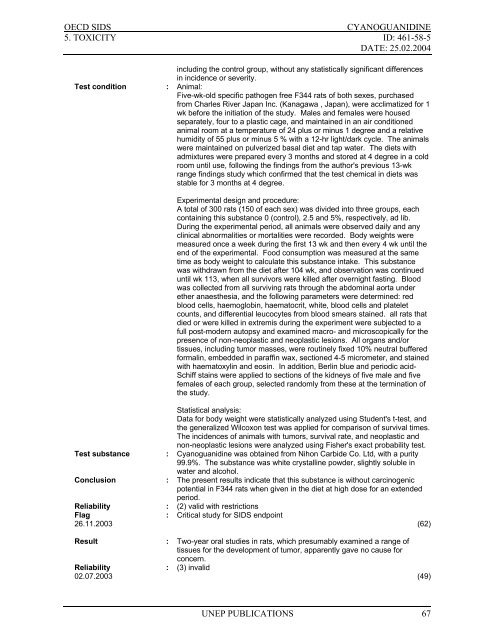Cyanoguanidine CAS N°: 461-58-5
Cyanoguanidine CAS N°: 461-58-5
Cyanoguanidine CAS N°: 461-58-5
You also want an ePaper? Increase the reach of your titles
YUMPU automatically turns print PDFs into web optimized ePapers that Google loves.
OECD SIDS<br />
CYANOGUANIDINE<br />
5. TOXICITY ID: <strong>461</strong>-<strong>58</strong>-5<br />
DATE: 25.02.2004<br />
including the control group, without any statistically significant differences<br />
in incidence or severity.<br />
Test condition : Animal:<br />
Five-wk-old specific pathogen free F344 rats of both sexes, purchased<br />
from Charles River Japan Inc. (Kanagawa , Japan), were acclimatized for 1<br />
wk before the initiation of the study. Males and females were housed<br />
separately, four to a plastic cage, and maintained in an air conditioned<br />
animal room at a temperature of 24 plus or minus 1 degree and a relative<br />
humidity of 55 plus or minus 5 % with a 12-hr light/dark cycle. The animals<br />
were maintained on pulverized basal diet and tap water. The diets with<br />
admixtures were prepared every 3 months and stored at 4 degree in a cold<br />
room until use, following the findings from the author's previous 13-wk<br />
range findings study which confirmed that the test chemical in diets was<br />
stable for 3 months at 4 degree.<br />
Experimental design and procedure:<br />
A total of 300 rats (150 of each sex) was divided into three groups, each<br />
containing this substance 0 (control), 2.5 and 5%, respectively, ad lib.<br />
During the experimental period, all animals were observed daily and any<br />
clinical abnormalities or mortalities were recorded. Body weights were<br />
measured once a week during the first 13 wk and then every 4 wk until the<br />
end of the experimental. Food consumption was measured at the same<br />
time as body weight to calculate this substance intake. This substance<br />
was withdrawn from the diet after 104 wk, and observation was continued<br />
until wk 113, when all survivors were killed after overnight fasting. Blood<br />
was collected from all surviving rats through the abdominal aorta under<br />
ether anaesthesia, and the following parameters were determined: red<br />
blood cells, haemoglobin, haematocrit, white, blood cells and platelet<br />
counts, and differential leucocytes from blood smears stained. all rats that<br />
died or were killed in extremis during the experiment were subjected to a<br />
full post-modern autopsy and examined macro- and microscopically for the<br />
presence of non-neoplastic and neoplastic lesions. All organs and/or<br />
tissues, including tumor masses, were routinely fixed 10% neutral buffered<br />
formalin, embedded in paraffin wax, sectioned 4-5 micrometer, and stained<br />
with haematoxylin and eosin. In addition, Berlin blue and periodic acid-<br />
Schiff stains were applied to sections of the kidneys of five male and five<br />
females of each group, selected randomly from these at the termination of<br />
the study.<br />
Statistical analysis:<br />
Data for body weight were statistically analyzed using Student's t-test, and<br />
the generalized Wilcoxon test was applied for comparison of survival times.<br />
The incidences of animals with tumors, survival rate, and neoplastic and<br />
non-neoplastic lesions were analyzed using Fisher's exact probability test.<br />
Test substance : <strong>Cyanoguanidine</strong> was obtained from Nihon Carbide Co. Ltd, with a purity<br />
99.9%. The substance was white crystalline powder, slightly soluble in<br />
water and alcohol.<br />
Conclusion : The present results indicate that this substance is without carcinogenic<br />
potential in F344 rats when given in the diet at high dose for an extended<br />
period.<br />
Reliability : (2) valid with restrictions<br />
Flag : Critical study for SIDS endpoint<br />
26.11.2003 (62)<br />
Result : Two-year oral studies in rats, which presumably examined a range of<br />
tissues for the development of tumor, apparently gave no cause for<br />
concern.<br />
Reliability : (3) invalid<br />
02.07.2003 (49)<br />
UNEP PUBLICATIONS 67
















